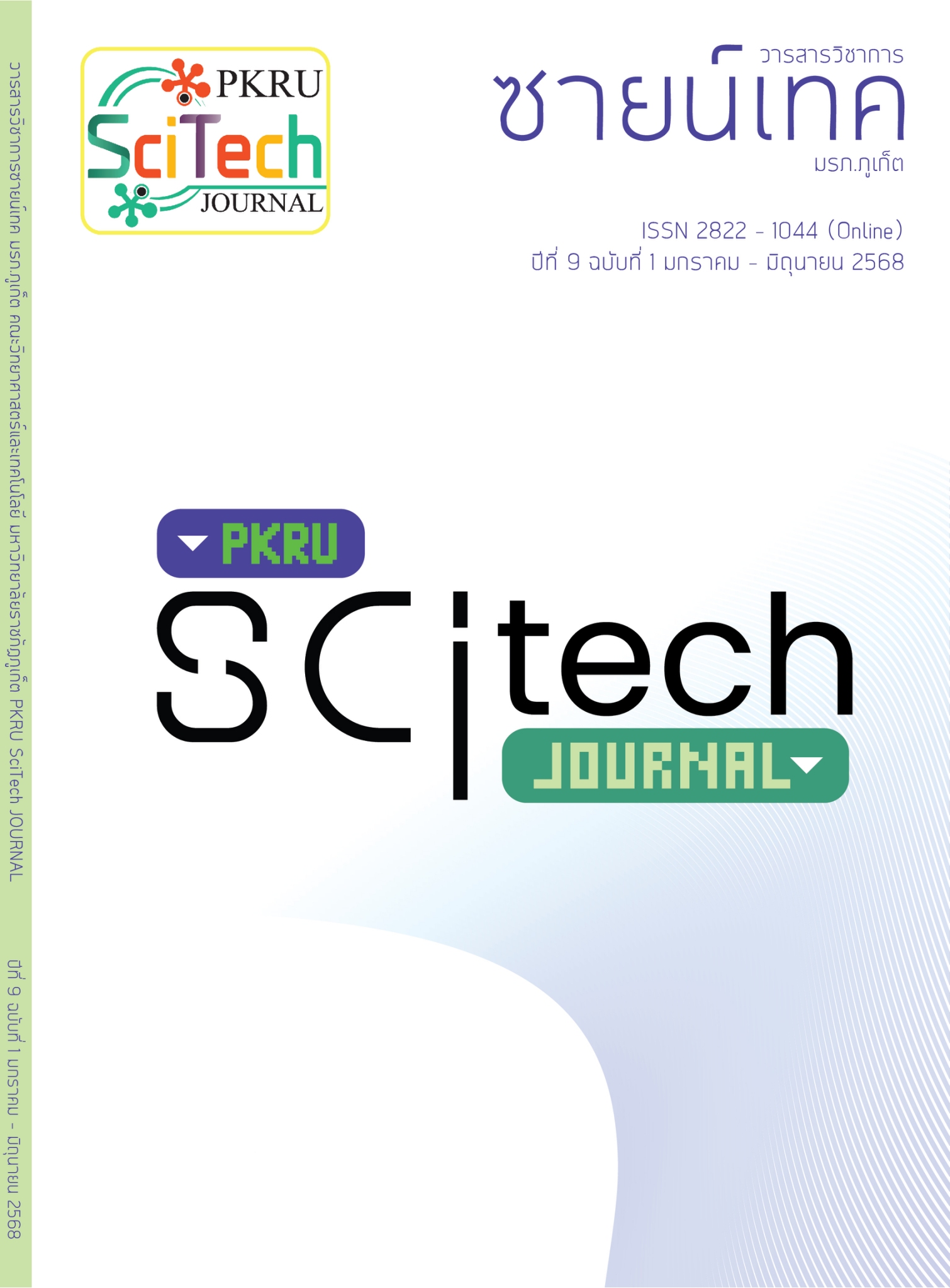Composition and Properties of Red Soil from Surat Thani for Developing Natural Color in Art
Main Article Content
Abstract
This research aimed to investigate the properties of natural pigments derived from local red soils in Surat Thani Province and establish knowledge for the development of natural clay pigment products. Soil samples were collected from Phanom and Khiri Rat Nikhom districts, focusing on Soil Group 26 (Ao Luk soil series) and Soil Group 34 (Fang Daeng soil series), both known for their distinct red hues. Soil sampling was conducted at three depth levels (0-10, 10-20, and 20-30 cm). The analysis included physical and chemical properties, including soil texture, pH, electrical conductivity, and soil color. The morphology, adhesion structure, and surface characteristics of pigment nanoparticles were examined using a scanning electron microscope (SEM). Mineral components in the soil were analyzed using the X-ray diffraction (XRD) technique. The results revealed that soil from Khiri Rat Nikhom exhibited high potential as a natural pigment source, containing significant amounts of hematite, stilpnomelane, and copper vanadium oxide, which contribute to a deep reddish-brown hue, particularly in the KRN-A area. SEM analysis revealed diverse shapes and sizes of soil particles, affecting their adhesion properties and dispersion on different surfaces. Therefore, red soil from Khiri Rat Nikhom District, Surat Thani Province, which has a high amount of hematite and red-colored minerals, and has an appropriate particle size, can be developed into natural color products for art, especially in the KRN-A area, which has the most outstanding properties. This will help reduce the reliance on synthetic colors, and provide a guideline for using environmentally friendly materials.
Article Details

This work is licensed under a Creative Commons Attribution-NonCommercial-NoDerivatives 4.0 International License.
- The original content that appears in this journal is the responsibility of the author excluding any typographical errors.
- The copyright of manuscripts that published in PKRU SciTech Journal is owned by PKRU SciTech Journal.
References
(1) Thoyib, M., Harsito, C., Basuki, Suyitno, S., & Hadi, S. (2018). Formulating water-based paint with red natural dyes. Journal of Advanced Research in Fluid Mechanics and Thermal Sciences, 52(2), 259–265.
(2) Affat, S. S. (2021). Classifications, advantages, disadvantages, toxicity effects of natural and synthetic dyes: A review. University of Thi-Qar Journal of Science, 8(1), 130.
(3) Hradil, D., Grygar, T., Hradilova, J., & Bezdicka, P. (2003). Clay and iron oxide pigments in the history of painting. Applied Clay Science, 22, 223–236.
(4) Siddall, R. (2018). Mineral pigments in archaeology: Their analysis and the range of available materials. Minerals, 8(5), 201.
(5) เก่งกาจ ต้นทองคำ, และจิดาภา ศรีสวัสดิ์. (2563). การศึกษาวัตถุจากธรรมชาติที่ให้สี เพื่อใช้ในการสร้างสรรค์งานจิตรกรรมไทย. ใน งานประชุมวิชาการระดับชาติ ครั้งที่ 12 มหาวิทยาลัยราชภัฏนครปฐม, 3626-3634.
(6) กรมพัฒนาที่ดิน (2548). ลักษณะและสมบัติของชุดดินในภาคใต้และชายฝั่งทะเลภาคตะวันออกของประเทศไทย. กรมพัฒนาที่ดิน.
(7) Soil Survey Staff. (2014). Soil survey field and laboratory methods manual: Soil survey investigations report No. 51 Version 2.0. Washington, DC: U.S. Department of Agriculture, Natural Resources Conservation Service.
(8) Li, Y., & He, B. (2011). Characterization of ink pigment penetration and distribution related to surface topography of paper using confocal laser scanning microscopy. BioResources, 6(3), 2690–2702.
(9) CILAS. (n.d.). Particle size and shape analysis in the paint, ink, and pigment industry. CILAS.
(10) Kadhim, H. K., & Alyounis, M. (2024). Effect of surface roughness on the interface behavior of clayey soils. Open Engineering, 10, 20220578.
(11) Soil Science Society of America. (n.d.). Soil color. In Soil Science Society of America (SSSA) Glossary. [online], retrieved from https://www.soils.org/discover-soils/soil-basics/soil-color (28 April 2025).
(12) Shi, W. (2020). Thermoelectric transport control using single phase materials and metamaterial composites. Doctor of Philosophy Dissertation.University of South Florida.
(13) Lu, Y., Dong, W., Wang, W., Ding, J., Wang, Q., Hui, A., & Wang, A. (2018). Optimal synthesis of environment-friendly iron red pigment from natural nanostructured clay minerals. Nanomaterials, 8(11), 925.
(14) Vodyanitskii, Y. N., & Savichev, A. T. (2017). The influence of organic matter on soil color using the regression equations of optical parameters in the system CIE-L*a* b*. Annals of Agrarian Science, 15(3), 380–385.
(15) Eastaugh, N., Walsh, V., Chaplin, T., & Siddall, R. (2004). The pigment compendium: A dictionary of historical pigments. Butterworth-Heinemann.
(16) Sirisathitkul, Y., & Sirisathitkul, C. (2025). Decoding Soil Color: Origins, Influences, and Methods of Analysis. Agri Engineering, 7(3), 58.
(17) Coccato, A., Moens, L., & Vandenabeele, P. (2017). On the stability of mediaeval inorganic pigments: A literature review of the effect of climate, material selection, biological activity, analysis and conservation treatments. Heritage Science, 5, 12.
(18) Natural Pigments. (n.d.). Pigment particle size: The role of particle size in art. [online], retrieved from https://www.naturalpigments.com/artist-materials/pigment-particle -size-role-in-art (28 April 2025).


